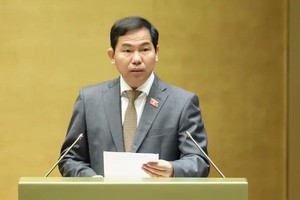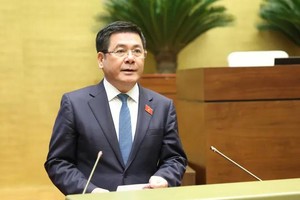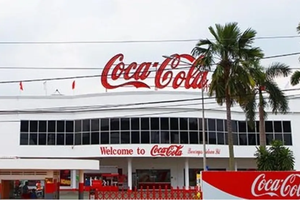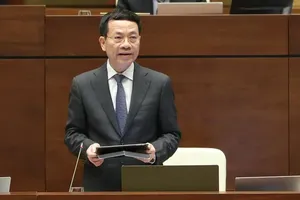Despite nearly 13 years since the implementation of Vietnam's Law on Prevention and Control of Tobacco Harms which took effect on May 1, 2013, the smoking rate among Vietnamese men over the age of 15 has demonstrably decreased to below 39 percent. However, a significant public health challenge persists: exposure to secondhand smoke in public spaces remains high, as reported by the Tobacco Harm Prevention Fund. This ongoing exposure underscores that, beyond the direct risks to smokers, the health of non-smokers continues to be jeopardized by tobacco use in shared environments.
Despite posted warnings, many people continue to smoke freely in no-smoking zones.
Limited progress in dealing with public smoking
Lieutenant Colonel and physician Nguyen Xuan Thanh of Military Hospital 175 shared findings from the International Agency for Research on Cancer (IARC), noting that cigarette smoke contains nearly 7,000 chemical compounds, including at least 69 carcinogens.
Among them, 11 are classified in Group 1 which are substances proven to cause cancer in humans. Smokers have a 25 times higher risk of developing lung cancer compared to non-smokers. Smoking is not only linked to lung cancer but also to numerous other cancers such as nasal, oral, laryngeal, tracheal, esophageal, stomach, pancreatic, kidney, bladder, cervical, bone marrow, and blood cancers.
Additionally, smokers are more susceptible to cardiovascular diseases, dental problems, blindness, and impotence. Secondhand smoke similarly harms non-smokers.
Despite the 2012 law's objective to curb smoking, the number of patients receiving treatment for tobacco-related illnesses has shown little decline. Observations at various smoke-free public locations in Ho Chi Minh City including Gia Dinh Hospital in Binh Thanh District, Binh Dan Hospital, Military Hospital 175, Saigon Railway Station in District 3, and Mien Dong Bus Station in Thu Duc City indicate that compliance with the regulation remains widespread.
Smoking declines in public facilities but it persists in restaurants across Ho Chi Minh City. Efforts to curb smoking in public spaces are showing progress, but challenges remain in certain venues, particularly restaurants and eateries. At Mien Dong Bus Station, for instance, a passenger was observed reaching for a cigarette, glancing around, and then opting to step outside to a designated smoking area, reflecting growing awareness of smoking regulations. Similar compliance is evident in healthcare facilities, schools, and government offices, where smoking has significantly decreased due to stricter enforcement and public awareness campaigns.
However, the scene at crowded venues like restaurants tells a different story. At B.S Restaurant in Hiep Binh Chanh Ward, Thu Duc City, numerous diners were observed smoking freely, with clouds of smoke permeating the air. This created discomfort for others, notably female patrons at nearby tables who were forced to relocate to avoid the secondhand smoke.
According to a staff member at T.K Restaurant on Hong Ha Street in Phu Nhuan District, the restaurant has designated smoking areas and ashtrays as required. Initially, customers comply, stepping outside to smoke. But after several beers, many light up indoors. Despite staff warnings, customers often ignore them, and the restaurant’s leniency results in smoke-filled rooms.
Stricter penalties are neccesary
Smoking poses significant risks to public health and places considerable economic strain on households, with many smokers acknowledging the dangers of both active and passive smoking. To address these challenges, the Vietnamese Government has implemented a comprehensive framework of legal measures aimed at reducing tobacco use and protecting public spaces.
Key regulations include the Law on Prevention and Control of Tobacco Harms, Decree No. 117/2020, which outlines administrative penalties in the healthcare sector, and Circular No. 11/2023-BYT, which mandates the enforcement of smoke-free zones and establishes awards for tobacco-free environments. These policies reflect a concerted effort to safeguard public health, promote awareness, and create healthier, smoke-free communities across the nation.
Despite these measures, the number of smokers remains high, with only a shift in smoking locations rather than a significant reduction.
According to Director Tran Quy of the Vietnam Institute for Digital Economic Development, one major reason people continue to smoke is the low cost and easy accessibility of cigarettes. In Vietnam, a pack costs just VND10,000–VND20,000 (less than US$1), making it affordable for nearly everyone. In contrast, cigarettes in Singapore cost ten times more, and in the U.S., a pack sells for around $10. Higher prices and stricter sales conditions help reduce smoking rates.
Legal expert Nguyen Van Khoi from the Vietnam Legal Consulting Center under the Vietnam Lawyers Association emphasized that while the tobacco harm prevention law has been in effect for nearly 13 years, low fines for public smoking and cheap, easily accessible cigarettes are why the smoking rate remains high. To deter public smoking, the Government should introduce Decree 168 in the health and environmental sectors—one that significantly raises cigarette prices and fines.
























